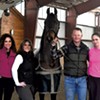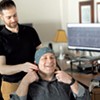Published September 14, 2005 at 3:27 p.m.
When Joy Scott and Seth Maley were told that their daughter Lisa was autistic, the news hit hard. Like many parents in their predicament, they were confused, overwhelmed and terrified, as if their daughter had just been handed a death sentence.
Initially, the diagnosis was hard to believe. As a toddler, Lisa had seemed so sociable, Scott recalls. She laughed a lot, had a healthy sense of humor, and loved people. As her mother puts it, "She was our delicious 2-and-a-half-year-old."
But as with many children diagnosed with an Autism Spectrum Disorder -- an umbrella term that covers a range of developmental disabilities involving delays or impairments in language, behavior and social skills -- Lisa's early childhood was also plagued with medical issues. She suffered from chronic ear infections, which, as her parents learned later, masked a pronounced auditory-processing problem. She was also in constant motion, had trouble maintaining eye contact, and eventually stopped progressing in her language skills.
Lisa was also incredibly stoic about pain and never cried or complained when she fell down or bumped into objects. "Her father played rugby for 20 years, so we always joked that she was inheriting his need to crash into things," Scott recalls wistfully.
Lisa is now 9. When people meet her, many don't realize she's autistic. In large measure, that's due to the intensive early intervention and treatment she received from Vermont's autism experts, who have helped her self-regulate and "prune away" the most obvious behaviors associated with autism. Today, Lisa is a veritable poster child for early intervention and how it can improve the lives of autistic children.
"When I thought about autism, I thought of a life without imagination," Scott recalls about her early misconceptions. "But in fact, Lisa is very expressive, through music and dance and theater and telling stories."
In large measure, her success can be credited to the quick timing of the diagnosis. According to autism experts, that's a key factor in determining how far an autistic child can progress. Today, the goal in Vermont is to identify the disorder as quickly as possible and begin intervention as early as age 2. Once that occurs, parents can turn to the growing network of Vermont parents who have already learned to navigate the confusing and often treacherous world of autism treatment and education.
"Once you get the diagnosis, you really have to hit the street running," says Maley. "You don't have time to process grief. You don't have time to look around you. There's a time window where the early intervention can be of maximum benefit. And that's a fairly close one, depending upon the age of your child."
Like other parents in their shoes, Scott and Maley quickly became experts on the subject, reading as many books and articles as they could get their hands on. About two weeks after Lisa's diagnosis, Scott visited Parent to Parent of Vermont, the nonprofit matches a family dealing with a disability with another family with experience facitn the same disorder.
"That was the first place I cried," recalls Scott. She still gets emotional talking about it six years later. "I didn't want people to feel like they should treat me with kid gloves because I was going to burst into tears. I wanted the truth, and I didn't want it sugar-coated."
Today, Scott and Maley are active members in that informal club of parents with autistic children. By all measures, membership in that club is growing fast. Vermont's autism rate has climbed dramatically in the last 15 years, from six cases in 1992-93 to 160 in 2000-01, according to U.S. Department of Educa- tion figures.
Admittedly, some of that increase is due to better diagnostic tools and evolving theories about what constitutes a mental disorder. Many children diagnosed today with an Autism Spectrum Disorder would have been labeled mentally retarded 10 years ago. Moreover, federal reporting of state autism rates wasn't mandated until 1991. As a result, experts caution that comparing figures from 2005 to 1991 is like comparing apples and oranges.
Nevertheless, a debate rages in the medical and psychiatric communities about whether autism's meteoric rise actually constitutes an epidemic. Ten years ago, the American Acade-my of Pediatrics estimated that one in 2500 children suffered from autism. Today, the Centers for Disease Control and Prevention put the figure at one in 166. Several years ago, the National Alliance for the Mentally Ill ominously described Vermont's autism rate as climbing at a "near infinite" pace.
But despite more than 10,000 journal articles written on the subject in the last two decades, the causes of autism are still unknown. Everything from genetics to the overuse of antibiotics to the global saturation of environmental toxins has been blamed. One leading theory is that autism may be caused by early childhood exposure to Thimerosal, a mercury-based preservative used in many childhood vaccines.
Is autism curable? That depends upon your definition of a cure, says Dr. Tom Ruffle, a developmental pediatrician with the Vermont Health Depart-ment's Child Development Unit. Ruffle, the doctor who diagnosed Lisa's autism at age 3, calls autism "a medical diagnosis with an educational treatment" that can, in his words, be "cured."
"It's well documented in the literature that 50 to 55 percent of the kids, if they're given an intensive early-intervention program, are able to function at age 7 in the school classroom without any supports," he says. While Ruffle acknowledges that those children will still have residual problems throughout their lives, "with intensive early intervention programs, there's real hope."
In Vermont, however, hope is often mitigated by geography. Ruffle also points out that, unlike other states, Vermont has no school specifically devoted to autistic children; the state's priority is to mainstream these students into the public schools. But services throughout Vermont remain spotty, he says, as does expertise within school districts. Ruffle believes that autistic children can thrive in a public school setting, provided they receive intensive one-on-one intervention from an early age.
Lynn George is a co-founder of Autism Support Daily, an information clearinghouse and support group for Vermont parents of children with autism. The group, which maintains an online discussion forum at its website -- www.AutismSupport Daily.com -- has about 160 members statewide. ASD also holds monthly meetings and events in Chittenden and Addison counties.
George agrees with Ruffle that the biggest challenge parents face in Vermont is the lack of autism experts in the schools. Too often, she says, districts are either unwilling or financially unable to bring in outside resources, relying instead on inexperienced or under-trained paraeducators to provide those services.
"So, in some districts, your child is a guinea pig," George says, "and if it doesn't work, it doesn't work, and you've wasted a lot of that child's educational time."
Lisa was fortunate in that she lives in Burlington and had access to well-trained autism interventionists close by, such as those at the Autism Spec- trum Program at the Baird Center in Burlington and the Philo Center for Sensory Based Evaluation and Treatment in Shelburne. Moreover, Scott credits the Burlington School District and acting Superinten-dent Lisane Collins for their emphasis on providing intensive autism services.
But Burlington pays a steep price for those services. Collins, who once coordinated an autism program in Scottsdale, Arizona, admits that the cost of intensive one-on-one services can be prohibitive. About three years ago, Burlington's population of 3- to 5-year-olds with autism jumped from two students to 10. Autism is now the district's fastest growing disability.
"If you have 10 kids, like we did, showing up at $36,000
per kid for an unbudgeted $360,000 hit, you start asking, OK, I need to meet the needs of these kids," Collins explains. "But is there a better, longer-term use of that money?" As a result, the district brought in outside autism experts from Baird to train its staff so that these students could receive ongoing attention as they make their way through the system.
In fact, a new documentary coming out this week profiles six Vermont families and their challenges in getting autism services for their children. Living the Autism Maze premieres this week at the Roxy Theater in Burlington. (For more information on the film, see this week's "Flick Chick" on page 60A.)
For her part, Scott is hopeful about Lisa's future. What was once a terrifying and potentially disabling diagnosis has become cause for optimism. In fact, last summer she and Maley told their daughter that she was autistic. Rather than getting upset, Lisa was excited to learn all about it. Scott, who now works for Families, Infants and Toddlers, a federally funded program for young children with developmental disabilities, says her family takes comfort in knowing that others with autism have overcome their disability and gone on to live normal and successful lives.
"I'm convinced Lisa is a child who, if she didn't get the intervention she got from age 3 to 6, would have eventually become a full-time ward of the state," Scott says. "But on the contrary, I think she's now a kid who will go to college, get married and work all through her life." She adds, "They don't even know how far these kids can go."
More By This Author
Speaking of...
-

Vermont Considers Paying Parent Caregivers of Adults With Disabilities
Apr 27, 2022 -

Video: Youths Compete in a Turkey Calling Contest in Castleton
Apr 21, 2022 -

With School Masking Guidance Lifted, Families With Medically Fragile Kids Feel Forgotten
Mar 23, 2022 -

Dog Biscuit Bakery Andy’s Dandys Builds an Inclusive Workplace
Aug 10, 2021 -

Video: Students Sing and Dance in Shaina Taub’s ‘Twelfth Night’ in North Hero
Nov 5, 2020 - More »
Comments
Comments are closed.
From 2014-2020, Seven Days allowed readers to comment on all stories posted on our website. While we've appreciated the suggestions and insights, right now Seven Days is prioritizing our core mission — producing high-quality, responsible local journalism — over moderating online debates between readers.
To criticize, correct or praise our reporting, please send us a letter to the editor or send us a tip. We’ll check it out and report the results.
Online comments may return when we have better tech tools for managing them. Thanks for reading.













































